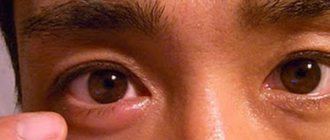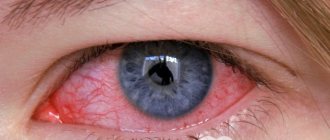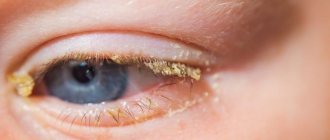One of the most common diseases that is often diagnosed in children and adults is conjunctivitis. This disease is characterized by the development of an inflammatory process in the mucous membrane of the eyes, the development of which is considered to be caused by contact with the surface of fungi, viruses and microbes.
In order to get an answer to the question of whether it is possible to become infected with conjunctivitis, you need to find out the reasons for the development of the disease. It is the influence of a certain causative factor that determines the nature of the course of the disease, as well as its ability to be transmitted from one person to another.
It has been proven that acute allergic and chronic conjunctivitis do not pose any threat to others and are not transmitted from a sick person to a healthy one. The most dangerous forms of the disease are conjunctivitis of bacterial and viral origin, which can be contracted through close contact.
A gathering of a large number of children is an ideal place for the spread of infection, since in kindergarten everyone uses the same toys, objects and is in close contact with each other.
For this reason, an important condition for effective treatment of the patient and preventing further spread of the infection is the complete isolation of the patient from the children's team until all symptoms disappear completely.
How the disease is transmitted
The source of infection can be a sick person or contaminated household items. Conjunctivitis is transmitted by airborne droplets and contact.
A vertical route of transmission is possible; if the mother has gonorrhea, the child may be infected during the passage of the birth canal. Read more about conjunctivitis in newborns→
Often, throughout the latent period, the carrier of the infection continues to be in contact with other children and poses a threat of infection to others.
Bacterial conjunctivitis
The causative agents of the bacterial form are pathogenic microorganisms such as streptococcus, gonococcus, staphylococcus. At the same time, the disease is not transmitted by airborne droplets, so being in the same room with a sick person does not pose a threat. You can become infected through direct contact (handshake, kiss), as well as through sharing household and hygiene items. The bacterial form of the disease has the following symptoms:
- eye irritation and erythema;
- severe peeling of the eyelid skin;
- yellowish pus;
- milky plaque on the mucous membrane.
Symptoms and types of disease
Diagnosing conjunctivitis in adults and children is not difficult, since the symptoms of inflammation of the connective membrane of the eye are similar. But children suffer the disease more severely; they become apathetic, restless and capricious.
Main symptoms of the disease:
- lacrimation;
- photophobia;
- swelling of the eyelids, the connective membrane of the eye;
- redness of the conjunctiva;
- decreased visual acuity;
- foreign object sensation or pain in the eyes.
Young children, even before the appearance of pronounced signs of the disease, become capricious and rub their eyes with their fists.
With isolated conjunctivitis, the temperature is normal or subfebrile; if inflammation of the connective membrane began against the background of a general infection, the body temperature may be elevated.
With allergic conjunctivitis, severe itching occurs. With bacterial conjunctivitis, bilateral eye damage occurs; usually, the disease first develops in one eye, and after 24-72 hours the infection spreads to the other eye.
Characteristic symptoms of bacterial conjunctivitis are purulent discharge, sticking of the eyelids, especially after sleep, and drying of pus on the eyelashes. The disease can be complicated by keratoconjunctivitis and blepharitis.
Sometimes, against the background of concomitant diseases such as anemia, bronchoadenitis, vitamin deficiency, etc., a child may develop corneal ulcers and deep keratitis.
Symptoms of purulent conjunctivitis in newborns begin 48-72 hours after birth. It is characterized by dense swelling of the eyelids of a bluish-purple color, infiltration and redness of the connective membrane, first serous-hemorrhagic exudate, and then purulent.
Often the disease is complicated by corneal ulcers, which are prone to perforation, which can cause leukoma, partial or complete blindness, endophthalmitis or panophthalmitis.
Signs of conjunctivitis caused by chlamydia in newborns are observed 5-10 days after birth. Older children can become infected when swimming in a closed body of water, which is why this type of disease is called “pool conjunctivitis.”
Symptoms of infection include redness and infiltration of the eyelid mucosa, drooping eyelids, liquid purulent discharge, and hypertrophy of the papillae. Often, the child simultaneously experiences extraocular infections: pneumonia, vulvovaginitis, pharyngitis and otitis.
Conjunctivitis caused by diphtheria bacillus usually occurs as a result of diphtheria of the throat and usually occurs in children no older than 4 years. Currently, thanks to universal vaccination against diphtheria, only isolated cases of the disease have been identified.
The patient's symptoms include painful, dense swelling of the eyelids; if they are pulled apart, cloudy serous-hemorrhagic discharge can be detected. Gray films that are difficult to remove are visible on the surface of the eye; after their removal, bleeding wounds remain.
Complications may include opacities and ulcerations of the cornea, perforation of the ulcer and death of the eye.
Conjunctivitis of viral etiology, as a rule, occurs against the background of acute respiratory viral infections, so catarrhal phenomena and high fever are observed simultaneously. One of the symptoms of viral conjunctivitis is a profuse, thin, watery discharge from the eyes, which makes the child's eyes appear as if they are constantly watering.
If conjunctivitis is caused by herpes, blistering rashes may appear on the eyelids and conjunctiva. In cases of measles conjunctivitis, a measles-like rash may be noticeable.
When the cause of conjunctivitis is chickenpox, smallpox pustules may be found, after opening which leave scars.
There are cases of secondary infection joining viral conjunctivitis, as a result of which purulent exudate is released from the eyes.
In addition, conjunctivitis can be acute and chronic. In the acute course of the disease, the clinical picture is clearly expressed. Chronic conjunctivitis is characterized by a feeling of “sand in the eyes,” eye fatigue, itching and burning.
Viral conjunctivitis
The development of viral conjunctivitis most often occurs in the autumn, since it is often a consequence of previous viral diseases. The main symptoms of its manifestation are purple eyes. In order to cure viral conjunctivitis, you will have to spend quite a lot of time, ranging from several days to several months.
This form of the disease is one of the most contagious, since the spread of infection can occur in several ways:
- when a healthy person comes into contact with a sick person;
- use of common household items;
- airborne infection.
That is why when asked whether such conjunctivitis is contagious, doctors almost always answer in the affirmative. Viral conjunctivitis is especially common in childhood and is most often diagnosed in children. The main place of its transmission and spread is preschool institutions and schools, where there is a large concentration of children.
When parents ask how long it will take for the disease to be transmitted from a sick child to a healthy one, doctors confidently state that a few hours of stay is enough.
It should be remembered that the patient poses a threat to others for several days after infection, and in more severe cases of a viral disease, this period can increase significantly. In order not to become infected with viral conjunctivitis, it is necessary to follow certain rules of conduct in everyday life:
- do not communicate with a sick patient or do it to a minimum, and the ideal option would be to place him in an isolated room;
- an infected person should use separate dishes, linen and towels, the main methods of disinfection of which will be boiling;
- do not touch the sore eye, but if this does happen, you must wash your hands thoroughly after each contact.
General rules of therapy
Before being examined by a specialist, it is advisable not to do anything, but when, due to circumstances, it is not possible to get to a doctor, then in case of suspected viral or bacterial conjunctivitis, you need to drip Sulfacyl Sodium into the eyes, which is allowed from birth.
If allergic conjunctivitis is suspected, the child should be given an antihistamine.
If a specialist diagnoses that the cause of conjunctivitis is viruses or bacteria, then every 2 hours the child should rinse the eyes with a solution of Furacillin (it is prepared at the rate of 1 tablet per 50 ml of boiling water) or chamomile.
You need to rinse your eyes from the outer edge of the eye to the inner. For these purposes, a sterile gauze pad is used, and it must be new for each eye. You can wash your baby with these solutions. As soon as the symptoms are not so strong, the number of washes is reduced to 3 times a day.
For allergic conjunctivitis, there is no need to rinse your eyes.
Even if inflammation is observed in only one eye, all procedures must be done with both eyes, since the infection quickly spreads to the second eye.
It is impossible to cover your eyes with a bandage during the inflammatory process, since microbes quickly multiply under them, and in addition, inflamed eyelids can be injured.
You can only put into your eyes those drops prescribed by your ophthalmologist. Sulfacyl sodium is usually prescribed for infants, Levomycetin, Tsiprolet, Normax, etc. for older children.
Tetracycline and erythromycin ointment should be carefully placed behind the lower eyelid, preferably at night.
Routes of transmission of different forms of the disease
In general
Most often, infection of a healthy person occurs as a result of close contact with an infected person or due to the use of common household items (towels, bed linen, etc.).
Viral
Stay up to date! This species develops against the background of human infection with measles, herpes, rubella, mumps and some types of influenza viruses.
Conjunctivitis does not develop in isolation, but is a consequence of a primary disease.
That is, inflammation begins after the activation of the infectious agent in organs and tissues, and the involvement of the mucous membranes of the organs of vision in the process.
The routes of infection depend on the specific type of pathogen :
- herpes virus – once it enters the body, it goes into a latent state. In case of favorable conditions (hypothermia, stress, pregnancy and other factors) it is activated, causing an inflammatory process in the conjunctiva. Transmission of the virus occurs through direct contact with damaged tissues of a human carrier or his biological fluids. Herpes remains viable for a long time in a humid environment. Therefore, infection is possible when visiting public places - swimming pools, baths, showers;
- measles - the spread of the virus occurs as a result of direct contact with a carrier or by airborne droplets. The risk of infection is associated with the presence of large crowds of people indoors ;
- Infection with conjunctivitis, which is a consequence of rubella , is possible through contact with a sick person, and infection also occurs by airborne droplets. If a pregnant woman is a carrier of the virus, the pathogen overcomes the placental barrier and enters the child’s body;
- inflammation of the protective membrane of the eye can occur against the background of mumps . The route of transmission of the virus is airborne : during direct or indirect contact with a carrier or infected material (saliva, urine, blood, household items);
- enteroviruses. The greatest danger is the Coxsackie virus, which causes hemorrhagic conjunctivitis. Infection occurs through contact with a carrier of the pathogen. In this case, this can be not only a person, but also household items, water, and food.
For your information! Certain types of viruses, in particular the herpes virus, remain in the body throughout a person’s life, moving from the active to the passive phase.
Therefore, conjunctivitis caused by this pathogen often recurs.
Purulent
The cause of purulent discharge from the eyes is always an infection caused by pyogenic bacteria.
The exudate also contains microorganisms that caused the appearance of pus.
Infection with the purulent form of the disease is possible through contact with particles of purulent discharge from a sick person (that is, when exudate gets into the eyes of a healthy person through the hands or after using shared towels or underwear).
Purulent conjunctivitis can be transmitted to humans from domestic animals .
Acute and chronic
Keep in mind! The acute form of viral or bacterial conjunctivitis is characterized by the period of greatest activity of the infectious agent.
At this time, infection of a healthy person is possible both through direct and indirect contact with a carrier of an infectious agent : close communication, use of common objects.
During the acute period of conjunctivitis, transmission of the pathogen also occurs by airborne droplets.
The chronic form of the disease is caused by the constant presence of pathogenic bacteria in the body in a passive state.
Infection with pathology occurs by airborne droplets or contact only if the disease transitions from chronic to acute form .
Bacterial
Note! In most cases, transmission of an infectious agent occurs through contact and household contact:
- gonococci . The mechanism of development of blenorrhea (gonococcal conjunctivitis) is the passage of the child through the infected birth canal of the mother. Blenorrhea in adults is most often caused by the introduction of the pathogen into the eyes of patients themselves suffering from gonorrhea of the genitourinary tract ;
- staphylococci - transmission occurs when the integrity of the skin is damaged (falls, insect bites), or consumption of contaminated food .
There are bacteria that are transmitted both by contact and by airborne droplets :
- streptococci;
- Pseudomonas aeruginosa - transmission of infection through the air occurs through close contact with a patient suffering from the pulmonary form of the disease. You can become infected with Pseudomonas aeruginosa by drinking water from contaminated sources.
The factor in the development of the disease is not only the penetration of bacteria into the body - the nature of the course of the disease is determined by the degree of contamination and the strength of the immune response.
Adenoviral
Keep in mind! This type of pathogen is a common cause of inflammation of the conjunctiva.
Viruses infect the mucous membranes of the human body, penetrating through household contact (“unwashed hands disease”) or through airborne droplets .
How to put drops into a child's eyes?
In order not to injure the eye, drops are instilled into children under one year of age using a pipette with a rounded end.
Place the baby on a flat surface and have someone help support his head. Pull back the edge of the lower eyelid and drop 1-2 drops; remove excess medication with a sterile napkin.
When a child closes his eyes, it is enough to drop the product between the upper and lower eyelids. As soon as the child opens his eyes, the drug will enter. You can also open a closed eye by stretching the eyelids in opposite directions with two fingers.
You should not use drops that have just come out of the refrigerator, as this will cause additional eye irritation. Cold medicine needs to be warmed in your fist.
You cannot use expired drops, without markings, or if they have been left open for a long time.
Older children can drip medications themselves, under adult supervision.
Treatment methods for various types of conjunctivitis
Depending on the cause of conjunctivitis, their treatment will be different:
- Bacterial conjunctivitis is treated with local antibiotics in drops (Levomycetin, Sulfacyl sodium) or ointments (erythromycin, tetracycline). When conjunctivitis develops against the background of another serious illness or is protracted, the doctor will prescribe oral antibacterial drugs.
- Viral conjunctivitis is treated depending on the pathogen. If there is herpetic conjunctivitis, an acyclovir-based ointment will be prescribed. Oftalmoferon, Poludan, Aktipol are prescribed as drops.
- Allergic conjunctivitis is treated with antiallergic drops (Cromoglin, Dexona, Allergodil) and oral antihistamines. In addition, you need to find out what provokes the allergic reaction and, if possible, avoid contact with the allergen. Such patients definitely need to consult an allergist, because allergies can progress and become more serious.
How many days are the different forms contagious?
Viral
In most cases of viral damage to the outer mucous membrane of the organs of vision, a person can infect others.
How contagious is it? This occurs from 1-2 days before the appearance of the first symptoms of the disease (that is, until the end of the incubation period) until the inflammatory process in the conjunctiva is eliminated.
In this case, a person is considered infectious for 7-10 days.
Purulent
Relief of mucopurulent discharge from the eyes (subject to proper treatment) occurs within 3-4 days.
Until these symptoms disappear, healthy people can become infected with particles of exudate from a sick person.
Acute and chronic
The acute form of conjunctivitis, caused by bacterial or viral etiology, lasts, in most cases, 4-5 days - during this entire period, the person affected by the disease is contagious.
Keep in mind! The duration of chronic inflammation of the protective membrane of the organs of vision can be up to 3 months.
But this form is characterized by the possibility of infecting others only if it enters the acute phase.
Bacterial
The disease is characterized by a short incubation period (1-3 days) and its treatment takes less time than with the viral form.
On average, the contagious period of bacterial inflammation lasts from 4 to 5 days.
Adenoviral
The incubation period of the disease is 4-7 days, the acute form lasts a week .
This type of virus is contagious during the incubation period, so a person can infect others even if a day has passed since he was infected.
A person is contagious for at least 14 days.
Remember! Most ophthalmologists recommend limiting contact with a sick person, starting from the moment the first signs of the disease appear until all symptoms disappear completely.
A slight reddening of the sclera may be a residual effect of cured conjunctivitis, but it is impossible to guarantee that the inflammation is completely stopped and the pathogen is destroyed.
Prevention
Preventive measures for conjunctivitis are as follows:
- Maintain personal hygiene, it is necessary to monitor the cleanliness of bedding and children's toys.
- Regularly ventilate the premises and maintain the necessary humidity using humidifiers and air purifiers.
- Monitor the child’s diet and, if necessary, give him pharmaceutical vitamins prescribed by the doctor.
- Strengthen the child's immunity through hardening.
- Walk at least 2 hours a day.
- Avoid contact with sick children and adults.
- Teach your child to use his own towel.
- Make sure your baby does not rub his eyes with his hands.
- If a foreign body gets in, do not try to remove it yourself, but contact a specialist; if you removed the object yourself, you still need to consult an ophthalmologist.
If the treatment is chosen correctly and carried out on time, then conjunctivitis goes away quickly and without complications. It must be remembered that only a specialist can answer the question of what caused the disease and how to treat it. You should not self-medicate and risk your child’s health.
Author: Irina Egorova, doctor, especially for Mama66.ru
Additional methods of transmission of conjunctivitis
Can you get conjunctivitis from an adult or child? In most cases, the answer to this question is yes. It is quite possible to get a viral or bacterial disease. Often what patients mistake for an allergic variant of the disease can also be attributed to one of the above. That is why you should adhere to basic hygiene rules when contacting such patients.
When deciding how else conjunctivitis can be transmitted, you should remember the following dangers:
- Failure to comply with hygiene rules when using contact lenses. These are products that improve vision. Since when installing them, the hands often come into direct contact with the conjunctiva, it is quite possible to get an infection from poorly washed hands;
- Handshakes. Business people cannot refuse simple rules of decency; it is often not possible to immediately wash their hands after shaking hands. However, there is a way out here too - use special disinfectants that are easy to apply to your hands and distribute. You can buy a compact tube that fits in your pocket, and carrying it with you is especially important during periods of exacerbation and spread of viral diseases;
- While playing with the baby. You shouldn’t even think about whether conjunctivitis in children is contagious. The younger generation is no different in this regard from adults. They are also susceptible to viruses and bacteria, and therefore you should not neglect the rules of hygiene and personal safety;
- Using low-quality or contaminated cosmetics. This often occurs when using common products, including when applying makeup before a group performance. Don't forget about the risk of infection;
- While swimming in public waters. Conjunctivitis is also transmitted during the use of public places for ablution - swimming pools, baths, swimming pools, saunas, showers, etc.
Having learned how you can become infected with conjunctivitis, a person is armed with knowledge and ways to prevent the spread of the unpleasant infection. To avoid long-term and painful pain afterwards, you should pay attention to eye hygiene. This is especially true when there is already a person on the horizon with obvious signs of conjunctivitis.











